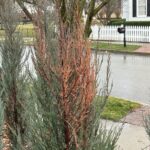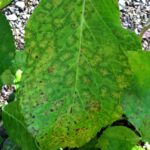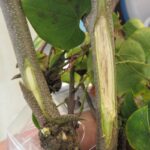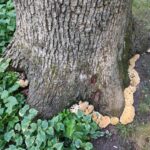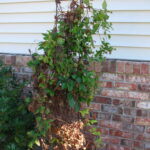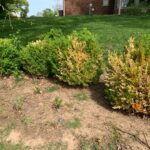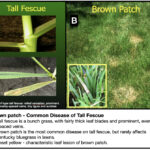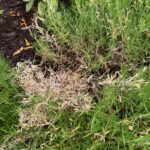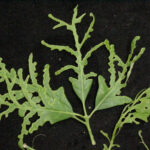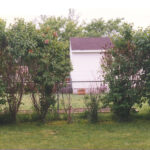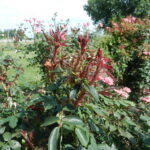Early June, we received a white pine sample at the Purdue University Plant and Pest Diagnostic Lab that showed early season needle loss lower in the tree canopy (Figure 1, 2). The majority of conifers hold onto their needles for multiple years, so loss of needles, even in the fall, can come as a shock[Read More…]
Resources for landscapes and gardens in the Midwest
Plant Diseases
Bill Walton, the legendary basketball player, sports announcer and perhaps the most outspoken and famous Grateful Dead fan, passed away in May leaving behind enough quirky quotes and euphemisms to make Yogi Berra proud. In a now viral clip since his passing, Mr. Walton reflects on teachings from his legendary coach and former Purdue basketball[Read More…]
The past two months have been relatively wet and cool to warm. This prolonged period of overcast conditions, high humidity, and light to moderate rainfall is perfect for some of our foliar disease issues. “April flowers bring May Leaf spots” doesn’t have the right ring to it, but we are seeing quite a bit of[Read More…]
Rocky Mountain juniper, Juniperus scopulorum, has gained some popularity in Midwest landscapes due to cold and drought tolerance, and to the availability of several upright columnar varieties with attractive blue color, including ‘Skyrocket’ and ‘Wichita Blue’. Like many other junipers, J. scopulorum may suffer dieback of small branches and twigs caused by the fungal pathogens[Read More…]
Identifying a plant problem is the first step to improve the health of plants in the landscape. We created a series of short (5 to 7 min) YouTube videos to help you learn or just brush up your plant diagnostic skills. Each video guides you through the diagnostic process in real landscapes, reviews pest biology[Read More…]
Identificar qué problema tiene la planta es el primer paso para mejorar la salud de las plantas en el jardín. Hemos creado una serie de videos cortos (5 a 7 minutos de duración) en YouTube. Esto lo hemos hecho para ayudarlo a aprender o simplemente mejorar sus habilidades de diagnóstico de plantas. Cada video te[Read More…]
Hydrangea L. (family Hydrangeaceae Dumort) is an all-encompassing description of a group of herbaceous and woody flowering plants, composed of more than 80 species native to Asia (including Japan), Indonesia, the Americas. Popular hydrangea species include the bigleaf hydrangea (Hydrangea macrophylla), also known as French hydrangea, panicled (peegee) hydrangea (H. paniculata), oak-leaf hydrangea (H. quercifolia) and mountain hydrangea (H. serrata). Hydrangea[Read More…]
Vascular streak dieback is an emerging issue on woody ornamentals in the nursery industry. We have provided information on this topic as the situation has been unfolding (https://www.purduelandscapereport.org/article/vascular-streak-dieback-of-redbud-what-plant-pathologists-know-so-far/; https://indianagreenexpo.com/sessions/vascular-streak-dieback-an-emerging-issue-in-nursery-stock/). Researchers and Collaborators working on vascular streak dieback will be presenting up-to-date information during the tHRIve webinar hosted by Horticultural Research Institute on Thursday, April 11,[Read More…]
Inonotus dryadeus is one of the more common wood decay fungi we receive at the diagnostic lab in association with declining trees, specifically oaks. Inonotus is found so frequently on oaks it has the common name oak bracket fungus, but it can cause root rot of a number of other hardwood trees (including maples, sweet[Read More…]
Dead man’s fingers is an apt moniker for a gruesome-looking fungus (Xylaria polymorpha and related species) that produces club-shaped fungal fruiting bodies that appear as fingers growing around the base of dying or dead woody plants and even wooden objects in soil (Fig. 1). With more than 25 species of Xylaria, generalizations are difficult to[Read More…]
The 2023 Purdue Turf and Landscape Seminar will be held on November 16th and 17th at the W.H. Daniel Turfgrass Research and Diagnostic Center in West Lafayette, IN. This event is designed for intermediate and advanced turf and landscape professionals, providing them with the latest technology for managing turf and landscape systems, and to maintain[Read More…]
Wet summer weather always brings in a surplus of plant diseases, but few are as dramatic as clematis blight, caused by the fungus now called Calophoma clematidina (formerly Ascochyta or Phoma clematidina) (Fig. 1). The rest of us simply call it clematis blight or clematis wilt. Why the confusion with both the common and Latin[Read More…]
In the last five years, we have received 233 samples from Indiana, alone, with concerns ranging from boxwood leafminer to Volutella dieback and cold damage (Figure 1, 2, 3). Often, we find multiple problems on any given sample, and very frequently we see Volutella in association with dark cankers of stems that appear to have[Read More…]
All plants are susceptible to attack by pests and pathogens. Under certain conditions, a homeowner may require the use of a pesticide, but only after they’ve included, or exhausted the use of cultural practices like removal of diseased tissue (sanitation and eradication); considered resistant varieties to replace continual problem plants; and making sure the plant[Read More…]
As we get into the throngs of summer, disease activity takes hold on the cool season turfgrass species we commonly use on lawns. This spring/early summer 2023 much of the state has been in a considerable drought, missing approximately two inches of normal precipitation in both April and May, and three inches below normal so[Read More…]
Creeping phlox (Phlox subulata) has been a reliable mainstay in home landscapes for generations. This spring-blooming perennial is also known by a string of other common names, including flowering moss, moss phlox, moss pink, rock phlox, and thrift (not to be confused with sea thrift which is Armeria maritma). Creeping phlox is native to a[Read More…]
Periwinkle (Vinca minor) has a few disease issues that can cause severe damage to Vinca in cool wet weather, including Rhizoctonia stem and crown rot, Phytophthora root and crown rot, and Phoma stem blight. The last disease, Phoma stem blight, can cause severe damage to Vinca early in Spring when new stem growth emerges (Fig[Read More…]
Each spring the PPDL receives several samples of oak trees showing curled, twisted, stunted and/or generally ratty looking leaves. When there are holes in the leaves or leaf edges are missing tissue, we add another symptom name to the mix: tatters. Distorted new growth and tatters are most common on white oaks and may occasionally[Read More…]
Pseudomonas syringae pv. syringae is an opportunistic bacterial pathogen that attacks a diversity of woody ornamental plants. The bacteria cause flower blights, cankers, shoot blights, and diebacks. Symptoms Symptoms often begin as expanding leaf spots. On lilac and viburnum, small spots expand to irregularly shaped brown lesions with yellow halos (Fig. 1). For most other hosts[Read More…]
Rose rosette disease is a severe problem for rose growers and occurs widely throughout many rose growing regions of the US, especially from the mid-South into the Midwest. The problem was described on roses in the early 1940s but actual cause of the disease remained murky until the pathogen was identified as a virus in[Read More…]
Sign-up to receive email news and alerts from Purdue Landscape Working Group:



